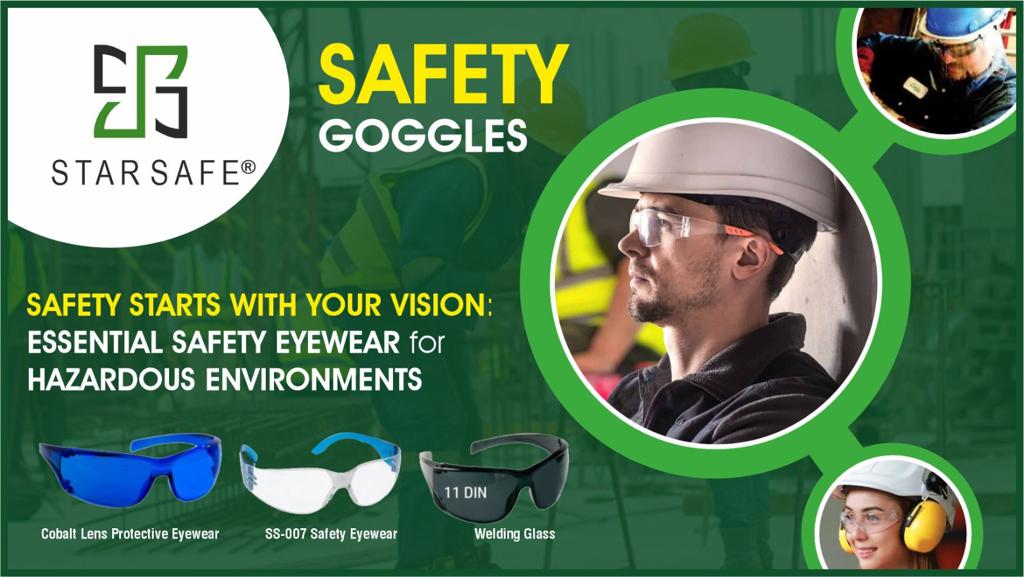
In hazardous work environments, protecting your eyesight is paramount. Whether you’re working in construction, manufacturing, chemical handling, or any other high-risk industry, safety eyewear plays a critical role in safeguarding your vision. According to the Occupational Safety and Health Administration (OSHA), thousands of eye injuries occur in workplaces each year, most of which could have been prevented with the right eye protection. In this blog article, we will explore the importance of safety eyewear and highlight the essential features and types of eye protection available to ensure your safety in hazardous environments.
Our eyes are incredibly delicate and susceptible to various workplace hazards, such as flying debris, chemical splashes, and harmful radiation. A split-second accident can lead to life-changing injuries, including blindness. Safety eyewear acts as a barrier, shielding your eyes from potential dangers, and reducing the severity of injuries in case of an accident. Wearing the appropriate safety eyewear is not just a choice but a necessity for workers exposed to hazardous conditions.
Types of Safety Eyewear:
A. Safety Glasses: Safety glasses are a versatile and commonly used form of eye protection. They are lightweight, comfortable, and designed to cover the entire eye area, providing defense against impact, airborne particles, and liquid splashes. Safety glasses come with various lens tints, catering to different working conditions, including clear, tinted, and anti-fog options.
B. Safety Goggles: Safety goggles offer a higher level of protection than safety glasses. They fit snugly around the eyes, forming a seal to prevent any debris or chemicals from reaching the eyes. Goggles are particularly suitable for environments where there is a risk of splashes, vapors, or airborne irritants, as they provide complete eye enclosure.
C. Face Shields: Face shields offer comprehensive protection for the entire face, including the eyes, nose, and mouth. They are typically used in conjunction with safety glasses or goggles for additional coverage against impact, chemicals, and extreme temperatures. Face shields are ideal for situations where there is a risk of large objects or intense heat exposure.
D. Welding Helmets: Welding helmets are specialized safety eyewear designed to protect welders from the intense light, heat, and sparks generated during welding processes. They have a tinted lens that darkens automatically when exposed to bright light, safeguarding the eyes from harmful UV and infrared radiation.
Essential Features of Safety Eyewear:
A. Impact Resistance: One of the most crucial features of safety eyewear is its ability to withstand high-velocity impacts. ANSI Z87.1 certification is an industry-standard that ensures the eyewear’s impact resistance. Look for safety eyewear marked with this certification to guarantee optimal protection.
B. Anti-Fog Coating: In humid or temperature-changing environments, fogging can impair vision and compromise safety. Safety eyewear with anti-fog coatings helps prevent condensation, ensuring clear vision at all times.
C. UV Protection: Safety eyewear with 100% UV protection shields your eyes from harmful ultraviolet rays, which can lead to long-term damage and eye conditions, such as cataracts.
D. Comfort and Fit: Comfortable safety eyewear encourages consistent usage. Look for designs with adjustable temples, padded nose bridges, and lightweight materials to ensure a secure and comfortable fit for extended wear.
E. Scratch Resistance: Scratch-resistant coatings on safety eyewear lenses increase their durability and longevity, preserving clear vision and ensuring long-term protection.
Proper Maintenance and Replacement:
To ensure the ongoing effectiveness of safety eyewear, proper maintenance is essential. Clean your eyewear regularly using mild soap and water, avoiding abrasive materials that could scratch the lenses. Inspect your safety eyewear before each use to check for any signs of damage, such as cracks or scratches, and replace them immediately if they are compromised. As a general rule, safety eyewear should be replaced every two years or sooner if damaged or excessively worn.
Safety eyewear is a non-negotiable aspect of workplace safety, especially in hazardous environments. By wearing appropriate eye protection, workers can significantly reduce the risk of eye injuries and protect their vision from potential harm. Whether it’s safety glasses, goggles, face shields, or welding helmets, each type of safety eyewear serves a specific purpose, catering to different working conditions. Remember, safety starts with your vision, and investing in high-quality safety eyewear is an investment in your well-being and long-term eye health. Stay vigilant, protect your eyes, and ensure a safer, healthier future in any hazardous work environment.
StarSafe Has a wide Range of Safety Eyewear and Spectacles check out our wide range of Safety Glasses and Spectacles by Clicking the link at https://www.starsafe.co.in/category/eye- protection/
